by Winding Pathways | Jun 15, 2023 | Nature, Reflections/Profiles, Wonderment
Sitting: it’s a rewarding outdoor activity. How can that be when everyone knows that being outdoors means movement? Hiking, cycling, skiing, canoeing, and swimming all get the heart beating and muscles working.
-
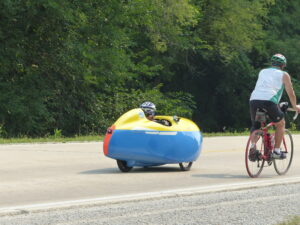
-
You see everything on RAGBRAI
-

-
Kayaking gets the heart pumping and strengthens the arms
We love all these activities but recently were reminded that sitting quietly is a fascinating and productive way to spend time outdoors. On a gorgeous May morning, we stopped at the road’s end in Iowa’s Brush Creek Canyon Nature Preserve. A narrow informal path lured us past a rock outcropping high above a gurgling brook.
We carried the sling chairs and binoculars that we keep in the car down a narrow informal footpath. Just a hundred yards later we found a level spot with a perfect view downward through trees to the water.
Sit we did. Enmeshed in secluded quiet we sat so still that warblers and vireos flitted among the trees. Even a hummingbird buzzed in front of us. A fly settled on Rich’s pants, explored a bit, and then went on its way.
Active outdoor activities are good for the body and mind, but sometimes sitting is the best way to notice our world and its inhabitants. When we scurry down a trail, wildlife hides or flees. When we sit and become part of the landscape, wildlife ignores the human presence and goes about its business.
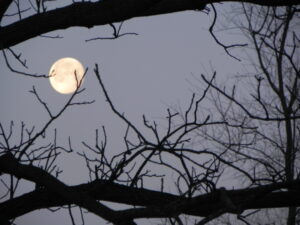
Tree branches help you watch the moon move across the sky.
Here’s our favorite sitting exercise that can be done almost anywhere. As a full moon rises, position a comfortable chair with tree branches or even overhead wires between it and the moon. Sit very still. Using branches or the wire as a reference it’s possible to watch the moon move.
Oh, Brush Creek Canyon. We recommend it as one of Iowa’s wildest natural gems. It’s just north of Arlington in Fayette County. Go outside. Have fun.
-

-
Couple by lake
-
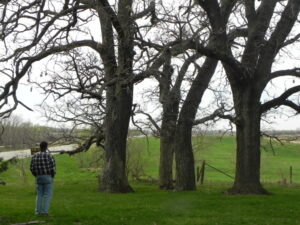
-
Wonderment
-
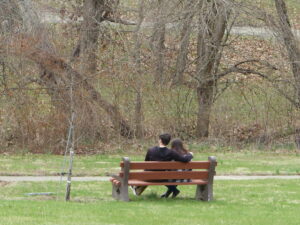
-
Finding peace
by Winding Pathways | Jun 8, 2023 | Garden/Yard, Nature, Pests
A “Hard Knock Life”
A tick’s life is hard. I’m hungry. I am a tick and I’ve been waiting a week for a juicy raccoon, dog, or wild turkey to walk by. Even a mouse would be welcome.
So far, no luck. I know a tick’s best bet for grabbing a passing animal is the “questing” position, so I’ve been hanging on to a branch with both pairs of my hind legs. My front pair of legs sticks out into the path ready to grab the fur or feathers of a passing animal. So far, no animal. Patience is hard and I’m hungry.
Larval Luck
I was luckier last year when I was a larva. I was hungry then, too, but the wait was short. A big, furry animal humans call a dog ambled by. Even though I only had six legs then I was able to grab a hold, and the rest was easy. I crawled around exploring under the fur until I found a spot with soft thin skin, dug in, and chowed down. Boy was that blood tasty! It was so nutritious that I left my host to grow and graduate. I’m now a tick nymph, complete with eight legs, but I need more blood to transform into an adult.
I’m still hungry. As I sit waiting, I admire the mosquitoes and flies that buzz by over my perch. They don’t need to be patient but can fly and search for a blood-rich victim. I can’t fly or jump, so all I can do is patiently wait until something walks by. I hope that’s soon because many of my fellow ticks starve.
Attracted to Carbon Dioxide and Moisture
What’s this? I sense a bubble of carbon dioxide and moisture. Might be the breath of an animal. Now I feel the vibration of footsteps. Must be a big animal. My front legs are outstretched in anticipation and I’m not disappointed.
I grab hold of a strange animal. It’s tall with only two legs. No hair. No feathers. Just some sort of covering over thin skin. No chance of biting through it, but I got a good grip on that covering and started climbing using all of my eight legs. Soon I was under what humans call pants and kept exploring and climbing. Bingo, I found a nice moist spot where my blood dinner was just beneath thin skin. I got ready to feast.
Then something happened. I should be happy with a meal so close at hand. Instead, I felt sick. My legs wouldn’t hold on and I dropped to the ground lifeless.
About Ticks
Pity the poor tick the above. Well, maybe not. It’s hard to pity an animal that can spread disease and discomfort. Ticks usually feed on mammals, birds, and even reptiles but if none come around, human blood suits them just fine.
Ticks are effective disease spreaders because of their relatively long life which can extend for two or three years and their habit of eating a blood meal during different life stages. This enables them to bite one animal carrying a disease in its blood and inject it into a different animal during a later feeding.
Seriously Avoiding Ticks
At Winding Pathways, we take ticks seriously. Rich has had Lyme disease twice, fortunately successfully cured by strong antibiotics. Other people are not as lucky and experience long-term symptoms. And, Lyme is not the only disease ticks spread.
Understanding ticks and taking precautions reduces the odds a person will be bitten and contract a disease from them.
How ticks Operate
Ticks are ambush hunters. As the tick describes above, they wait for a victim to pass within grabbing distance of their front legs. Often ticks walk around on their victim for several hours before they dig through the skin and help themselves to a blood meal.
In order to contract a tick-borne disease a victim must be bitten, so a walking tick won’t transmit illness.
Reduce Your Odds
We often explore the woods, work in our yard and garden, and generally spend time in tick country. Here are precautions we take that reduce the odds of a tick bite:
- We spray our outdoor clothes and shoes with permethrin. It lasts for several washings and kills ticks. The hapless tick described above fell victim to this chemical.
- We often tuck our pants legs into our socks, sprayed with permethrin, to make it hard for any tick that gets on our socks or pants to get under them.
- After returning to the house, we disrobe and shower after we have checked for ticks. They prefer moist dark body areas so we especially check those places. Clothing goes into the washer.
- We watch for symptoms of Lyme Disease, especially a rash and fatigue. If they appear we call our physician immediately.
Promising Product
A few years ago, Rich was so determined to prevent another Lyme Disease incident that he invested in socks, pants, and shirts from Insect Shield. The company infuses its clothing with permethrin that, they claim, is effective for at least 70 washings.
Does this chemical work? Is Insect Shield clothing worth buying? Well, since wearing it Rich hasn’t found a tick on him and he’s been free of Lyme Disease. That’s not a scientific verdict but it’s good enough for him to keep wearing the clothes.
-
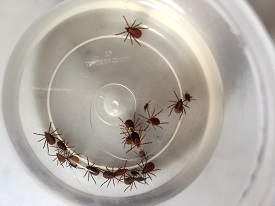
-
Tiny ticks can cause problems, so we go prepared in nature.
-
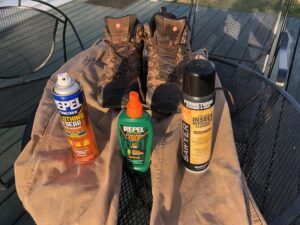
-
Pants, boots, varied sprays can reduce odds of picking up ticks
-
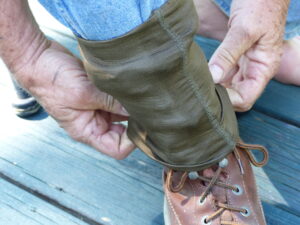
-
gaiters with tick guard helps repel ticks.
-
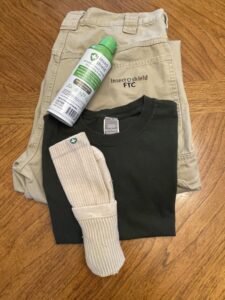
-
Pants, shirts, and socks infused with permethrin appear to keep ticks off.
Disclaimer
Rich purchased his Insect Shield clothing at the retail price. He’s still testing them but they seem to work. Winding Pathways was not paid for this blog.
by Winding Pathways | May 25, 2023 | Foraging, Nature
The Guys Do the Work
Some aspects of sunfish sex are bizarre. Here is a huge family of many species of fish where the guys do the hard work caring for their babies. That’s unusual in the animal kingdom, where normally mom cares for the young.
There are many sunfish species. Most are native to the eastern United States but they’ve been stocked all over the world. Bluegills, pumpkinseeds green sunfish, and crappies are abundant, easy to catch, and tasty. That’s why they’re called “panfish.” Largemouth and smallmouth bass also belong to the Centrarchidae, or sunfish, family but most people consider them gamefish.
How It Works
As water warms in the spring, the males of most sunfish species create a round depression in the sand in shallow areas of a lake or pond. Females don’t help a bit with nest building and spend their days cruising the water seeking tasty invertebrates to eat. They visit a nest only to lay eggs, which are immediately fertilized by the tending male. She leaves. He stays. Lots of pesky small fish love eating sunfish eggs, so the poor male spends his days chasing them off. Finally, after the eggs hatch and babies leave the nest, he’s free to join the females roaming the pond.
Many sunfish species nest throughout the warm months, while others, like bass and crappies, have one spawning season. One part of sunfish sex is absolutely strange.
Unusual Area
A four-acre pond where Rich fishes has relatively deep water and only one shallow area suitable for sunfish to nest. It is small so round nests are crowded together, forcing the two sunfish species to spawn near each other.
Green Sunfish are smallish but aggressive colorful fish with relatively large mouths. They usually dwell in rocky areas. Bluegills are one of the largest of the sunfish. When both nest in close proximity hybrids result. They look a little different from each parent species. The strange part is that nearly all the hybrids are males!
Sunfish are amazingly common, fascinating, and often colorful. Males are fun to watch as they patrol their circular nests driving off intruders.
-
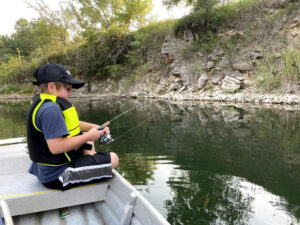
-
Sunfish are fun to catch.
-
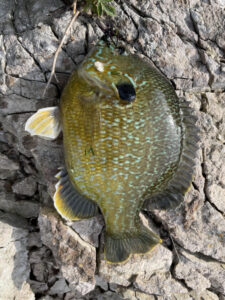
-
Chunky hybrid sunfish.
by Winding Pathways | Apr 27, 2023 | (Sub)Urban Homesteading, Birds, Nature
Sometimes we feel sorry for Lonely Louie, so sorry that we toss him a scoop of corn.
Flocks of wild turkeys have been visiting our yard almost daily for years. Most often we see gobbler groups. They are adult males with long beards and spurs. Once in a while a group of hens stops by to glean seeds under our bird feeders. They are sleeker than males and lack a beard. And, rarely, hens appear with a clutch of poults. An exciting event indeed!
-
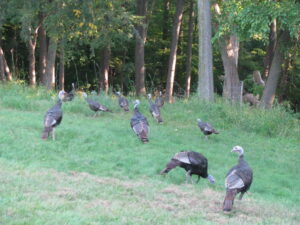
-
A dozen or so males routinely visited the yard.
-
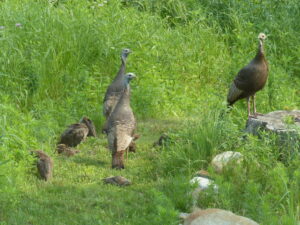
-
Rarely we would see hens with young.
About two years ago a threesome of males began visiting every day. Sometimes two or three times a day. We called them Huey, Duey and Louie. They seemed inseparable, and we never saw them alone. Late evenings we sometimes watched them flap up to tall tree branches to roost for the night.
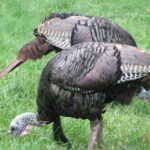
Huey and Louie
Then, only two visited. Huey and Louie. We never learned what happened to Duey. Maybe a predator enjoyed him for a meal. Or, he may have had an accident. It is a mystery, but we continued enjoying visits by the other two.
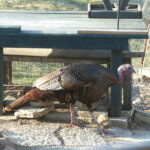
Lonely Louie looks for corn
One day Louie showed up alone. We haven’t seen his companion since. Lonely Louie is now trully a loner. If he’s in the yard and a flock of turkeys appears Louie stays away. He seems shunned by the others. Maybe he’s just shy.
He seems to miss his two friends. So do we, but we enjoy seeing Lonely Louie and know he appreciates the scoop of corn we toss out when he arrives.
by Marion Patterson | Apr 13, 2023 | Amphibians/Reptiles, Birds, Flowers/Grasses, Hearing, Nature, Wonderment
A Season of Variables
After a drab March “look up, look down, listen” season is here. It’s exciting and frustrating. Always something to see and hear and things we miss, too.
What is look up, look down, listen? Well, when we walk in woods and prairies, we’re always attuned to nature’s beauty and curiosities. In the Northern Hemisphere April and May force challenges and delights, as the earth turns toward the sun. Its warmth stimulates new life while welcoming arrivals from down south.
Here in Iowa, like much of the United States, bird migration rises through April and peaks in early May. Woods, wetlands, and prairies are filled with bird species we haven’t seen since last year.
Look Up!
“Look up,” Marion remarked on one April walk last year. She spotted the first Rose Breasted Grosbeak of the season. He was perched on a thin branch high in a sycamore tree. As we walked along, we kept looking up to spot other new arrivals. They added color and song to those of cardinals, chickadees, and woodpeckers who are our neighbors all year.
-
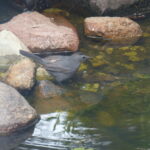
-
A catbird drinks by a pool.
-
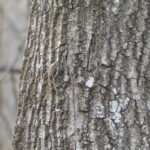
-
The brown creeper blends in with tree trunks.
Look Down!
After admiring the Grosbeak and moving on, I said, “look down.” We had been paying so much attention to birds up in the trees that we almost trampled a Dutchman’s Breeches, a delicate white wildflower with petals shaped like old-time Dutch pants. Looking down revealed spring beauties, Mayapples, hepatica, and anemones. Some were not quite in bloom and a few had gone by, but most were in their spring glory.
-
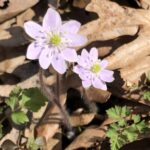
-
Early spring flowers
-

-
Reaching for the sun
-
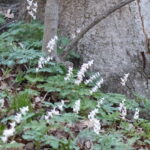
-
Dutchman’s Britches
-
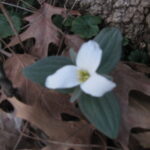
-
Snow Trillium
Shhhh! Listen
Passing a low wetland, we both paused to hear the songs of the chorus frogs and peepers that greet listeners each spring between the vernal equinox and Easter.
So, what do we do on a spring walk? Look up or down or listen? All of these. It is the best time of year to enjoy beauty clinging to the soil, singing from treetops, and chorusing from ephemeral pools.
Make Nature ID easier with Apps
Spotting birds hiding invisibly in tangles of branches and vines is challenging. What’s in that thicket singing? Thanks to the Cornell Laboratory of Ornithology, we turn on our Merlin app, point the phone where the songs originate, and learn who’s singing. Merlin is easy to download from the app store. Sometimes we are lucky and watch migratory birds close at hand.
Some people even lure birds in with treats that are eagerly consumed by arriving birds.
Wildflowers cannot hide but can be confusing. We sometimes use an app called SEEK to identify ones that are mysterious to us. SEEK is also easy to download from the app store and can also help identify trees, weeds, and other living things.
Look up, look down, listen! season may be the very best time to be outside. We love it.
by Winding Pathways | Apr 6, 2023 | Birds, Nature
Yellow-bellied sapsuckers are precise timers. Every late March we look for this gorgeous, yet sometimes hard-to-spot, migrating bird. They visit our woods in April on their way to northern breeding areas.
Weather Conditions
Late March and April nights are often below freezing, followed by warm days. That temperature fluctuation stimulates maples to send sap upward. At the same time, the warmer days awaken hungry insects seeking sweet meals. Yellow-bellied Sapsuckers arrive from the south at sap time and make their familiar wells, or small rows of holes, through maple bark. Sap oozes out and attracts protein-rich insects. Hungry migrating sapsuckers dine on both sweet sap and tasty insects.
Yellow-bellied Sapsuckers are Precise Timers
Yellow-bellied Sapsuckers time their migration precisely. They arrive exactly when conditions are perfect. Within a few weeks the weather warms, maples stop bleeding sap, insects disperse, and the birds are north of us getting ready to nest.
-
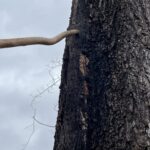
-
Insects are attracted to the sap weeping from maple trees.
-
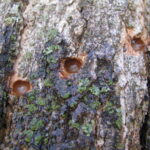
-
sapsuckers time their arrival well.
























